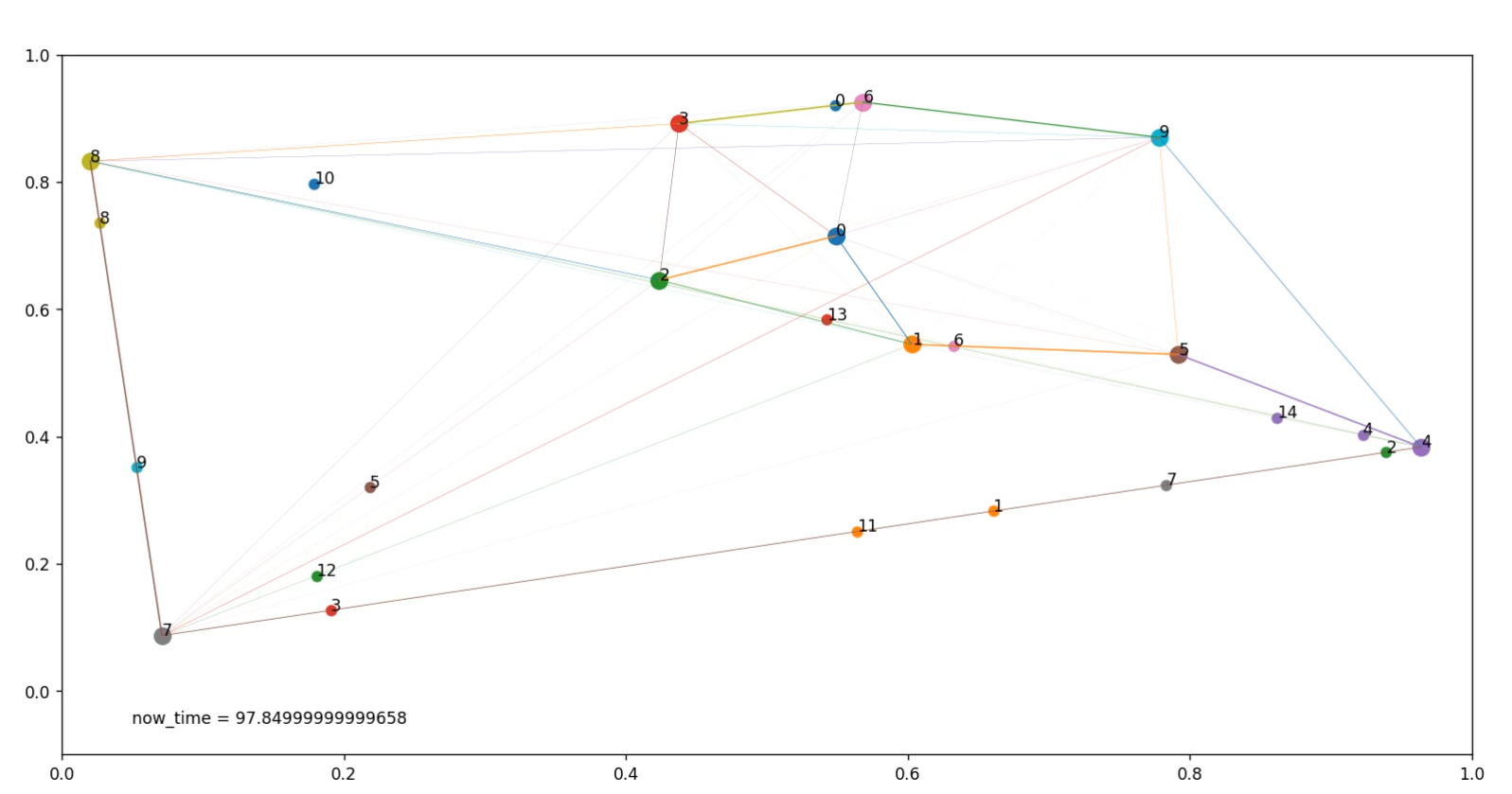The ant colony algorithm is used here to solve the traveling salesman problem, and simpy is used for drawing.
The function to select the next food is:
probability[i] = pheromone[self.now][self.not_to_foods[i]] ** pheromone_w + (
1 / distance[self.now][self.not_to_foods[i]]) ** distance_w
Probability weight of this path = pheromone at this point ^ pheromone weight * (1/path length) ^ path weight / sum. Random.choices will be used here later, so there is no need to except it.
Pheromones updated to:
new_pheromone[self.route[i]][self.route[i + 1]] += pheromone_Q / self.sum_lenpheromone = np.add((1 - volatilize) * pheromone, new_pheromone)
The total pheromone will volatilize proportionally, and then each section of all ant paths plus a fixed amount of released information/total length of the path
Not much to say, it’s all in the code comments
import random
import simpy
import matplotlib.pyplot as plt
import numpy as np
# 在这里我们尝试用蚁群算法求解旅行商问题,简而言之,就是寻找一条链接所有点的最短路径最后要回到初始点
# 我想绘制一下每只蚂蚁的行走过程,所以使用上次的simpy包来模拟一下,
# 这个simpy包主要是为了更好的可视化模拟训练过程,你也可以给每只蚂蚁单独线程代替,
# 或者干脆不用管过程,只用一轮一轮的上蚂蚁,在信息素部分做点处理,光看结果也可以。总之大多要比simpy快
class Ant(object): # 蚂蚁类
# 说一下训练过程,有很多只蚂蚁,从随机位置出发,
# 每次遵从信息素的指引,选择下一个城市,直到没有可选城市,回到初始位置然后根据路径总长度在路径上散播信息素
def __init__(self): # 蚂蚁构造函数
# 一只蚂蚁,只需要保存走过的食物就可以,
# 这里我们为了以后整信息素时不用遍历,顺便保存一下走过的长度
self.route = [] # 到达食物路径,一个例子是:[2,1,3,2]
self.not_to_foods = [] # 未到达的食物点
self.sum_len = 0 # 走过路径总长度
self.now = 0 # 当前所在位置
self.next_food = 0 # 下一个所在位置
self.Initial_Position(random.randint(0,foods_n-1)) # 设定初始位置
# 绘图参数
self.now_position = [0, 0] # 起始到终点的向量
self.proportion = env.now # 走的时间,画图就是找到起始食物点,然后加上(起始和终点的向量乘以(当前时间-出发时间)/路长)就是蚂蚁位置,
def Initial_Position(self, n): # 选择初始位置'
self.now = n # 当前所在的食物
self.next_food = n # 下一个要到的食物
self.route = []
self.not_to_foods = [i for i in range(foods_n)] # 未到达的食物点
self.sum_len = 0
self.route.append(n) # 添加到路径
self.not_to_foods.remove(n) # 初始点不会在未到的食物点
def Set_Now(self, next_food): # 到下一个点
self.next_food = next_food # 下一个要到的食物
self.route.append(next_food) # 添加到路径
self.sum_len += distance[self.now][next_food] # 总路径增加
if next_food in self.not_to_foods:
self.not_to_foods.remove(next_food) # 移出未到的食物点
self.now_position = foods[next_food] - foods[self.now] # 走的方向
self.proportion = env.now # 出发时间
def Next_Food(self): # 根据信息素和路径寻找下一个食物
len_not_to_foods = len(self.not_to_foods) # 没选择的食物个数
probability = np.zeros(len_not_to_foods) # 选择食物的概率
for i in range(len_not_to_foods):
# 选一个路径的概率是该点信息素^信息素权重*(1/路径长)^路径权重/总和,这里后面会用random.choices就不用除了
probability[i] = pheromone[self.now][self.not_to_foods[i]] ** pheromone_w + (
1 / distance[self.now][self.not_to_foods[i]]) ** distance_w
next_food = random.choices(self.not_to_foods, probability) # 根据权重选择下一个点
return next_food
def Change_Pheromone(self): # 更新信息素矩阵,先添加到一个临时变量中,信息素矩每隔一段时间后自己会挥发并将这个变量添加进去。
for i in range(foods_n):
new_pheromone[self.route[i]][self.route[i + 1]] += pheromone_Q / self.sum_len
new_pheromone[self.route[i + 1]][self.route[i]] = new_pheromone[self.route[i]][self.route[i + 1]]
def run(self): # 蚂蚁出动
global min_distance, min_route
while True:
while self.not_to_foods: # 未空还能找食物
next_food = self.Next_Food()[0]
self.Set_Now(next_food) # 根据信息素和路径去下一个食物位置
yield env.timeout(distance[self.now][next_food]) # 等待到达终点
self.now = next_food # 到达位置
# 没有食物可以去了
next_food = self.route[0]
self.Set_Now(next_food) # 去初始点
yield env.timeout(distance[self.now][next_food]) # 等待到达终点
self.now = next_food # 到达位置
self.Change_Pheromone() # 到了初始点之后,更新信息素
if min_distance > self.sum_len:
min_distance = self.sum_len
min_route = self.route
self.Initial_Position(random.randint(0,foods_n-1)) # 重新初始化,再来一轮
def Change_Pheromone(env):
global pheromone, new_pheromone
while True:
# 每隔一段时间,挥发,更新信息素,
# 我想要平均走完一波蚂蚁更新一波,那么,我大概需要等待平均总路长的时间(因为假设蚂蚁1m/s)这里就用(foods_n+1)/2,两点间平均距离大概是0.5
yield env.timeout((foods_n + 1) / 2)
pheromone = np.add((1 - volatilize) * pheromone, new_pheromone)
new_pheromone = np.zeros((foods_n, foods_n))
# 初始化函数,初始化蚁群,食物,信息素矩阵,
def Initialization(ants_n, foods_n, dimension):
'''
:param ants_n: 蚁群大小
:param foods_n: 食物数目
:param dimension: 维度
:return: 初始化蚁群,食物,信息素矩阵,距离矩阵
'''
ants = [Ant() for _ in range(ants_n)] # 蚁群
np.random.seed(0) # 随机数种子,让生成的位置一致,你可以删去
foods = np.random.rand(foods_n, dimension) # 所有食物位置,支持高维,不过绘图只有二维(python三维图太卡了),只测试二维
pheromone = np.zeros((foods_n, foods_n))+2 # 信息素矩阵初始为路径长度平均数的倒数之类的
distance = np.zeros((foods_n, foods_n)) # 距离矩阵
for i in range(foods_n): # 计算欧氏距离
for j in range(foods_n):
if i > j: # 以前算过了,抄过来
distance[i][j] = distance[j][i]
continue
if i == j: # 一样的位置就是0,不算了
continue
distance[i][j] = np.sqrt(np.sum((foods[i] - foods[j]) ** 2))
return ants, foods, pheromone, distance
def plt_Refresh(): # 绘图
while True:
plt.clf() # 清屏
plt.xlim(0, 1)
plt.ylim(-0.1, 1)
# 绘图
plt.text(0.05, -0.05, "now_time = " + str(env.now))
for i in range(foods_n): # 所有的食物点
for j in range(i):
plt.plot([foods[i][0],foods[j][0]],[foods[i][1],foods[j][1]],linewidth=pheromone[i][j]/100)
plt.scatter(foods[i][0], foods[i][1], 100)
plt.text(foods[i][0], foods[i][1], i)
for i in range(ants_n): # 所有的蚂蚁点
# 到起始食物点,然后加上(起始和终点的向量乘以(当前时间-出发时间)/路长)就是蚂蚁位置,
if ants[i].now == ants[i].next_food:
position = foods[ants[i].now]
else:
position = foods[ants[i].now] + ants[i].now_position * (env.now - ants[i].proportion) / \
distance[ants[i].now][ants[i].next_food]
plt.scatter(position[0], position[1])
plt.text(position[0], position[1], i)
# 刷新图形
plt.draw()
plt.pause(time_particles)
yield env.timeout(time_particles)
def Firing(env): # env启动
env.process(Change_Pheromone(env)) # 启动信息素矩阵
env.process(plt_Refresh()) # 启动绘图
for i in range(ants_n): # 启动所有蚂蚁
env.process(ants[i].run())
ants_n = 15 # 蚂蚁数目,一般1.5*foods_n
foods_n = 10 # 食物数目
dimension = 2 # 维度,建议2,因为绘图只搞了2
min_distance = float("inf") # 最小距离
min_route = [] # 最小路径
# 一些超参数
pheromone_w = 1 # 信息素权重
distance_w = 6 # 距离权重
volatilize = 0.5 # 信息素挥发比例
pheromone_Q = 10 # 总信息素
run_time = 100 # 模拟时间
time_particles = 0.05 # 绘图间隔
new_pheromone = np.zeros((foods_n, foods_n))
# 绘图
plt.figure()
plt.pause(10) # 方便我录屏,等10s再出画面你们要删去
env = simpy.Environment() # 设置环境并启动模拟
ants, foods, pheromone, distance = Initialization(ants_n, foods_n, dimension) # 初始化,通常,蚁群数目是食物数目1.5倍
print(foods)
Firing(env) # 开火,启动(添加要模拟的函数)
env.run(until=run_time) # 运行模拟
print(min_route,min_distance)
plt.show() # 遍历完成后不消失
Use your own suggestions to delete the plt.pause(10) line. At the same time, you can increase time_particles.
This is the result:

The video review has not passed yet. It will be released once it passes.
